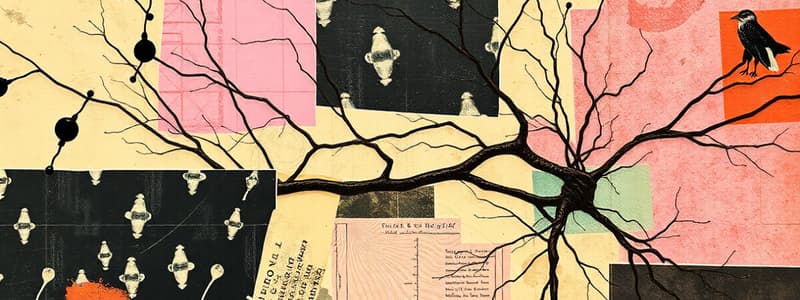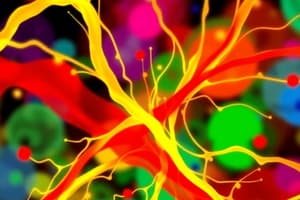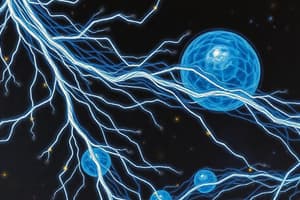Podcast
Questions and Answers
What is the primary structural component of microtubules?
What is the primary structural component of microtubules?
- Actin monomers
- Heterodimers of α- and β-tubulin (correct)
- Cytoplasmic filaments
- Intermediate filament proteins
What role do microtubules play during cell division?
What role do microtubules play during cell division?
- Creating the mitotic spindle (correct)
- Facilitating cytokinesis
- Forming the nuclear envelope
- Generating cellular energy
How frequently do microtubules change in length on average?
How frequently do microtubules change in length on average?
- Every 30 minutes
- Once an hour
- Approximately every 10 minutes (correct)
- Constantly without a defined time frame
Which of the following is NOT a function of microtubules?
Which of the following is NOT a function of microtubules?
What is a critical characteristic of microtubules that affects their function?
What is a critical characteristic of microtubules that affects their function?
What is the primary mechanism by which colchicine exerts its anti-inflammatory effects?
What is the primary mechanism by which colchicine exerts its anti-inflammatory effects?
Which motor protein is responsible for moving vesicles toward the minus end of the microtubule?
Which motor protein is responsible for moving vesicles toward the minus end of the microtubule?
What structural component makes up the core of the microtubule organizing center?
What structural component makes up the core of the microtubule organizing center?
In which cellular process are centrioles crucial?
In which cellular process are centrioles crucial?
What type of protein interacts with microtubules to assist in the cellular movement of organelles?
What type of protein interacts with microtubules to assist in the cellular movement of organelles?
What is the primary role of contractile bundles in cellular processes?
What is the primary role of contractile bundles in cellular processes?
Which cyclin is synthesized in the early G1 phase and interacts with CDK4 and CDK6?
Which cyclin is synthesized in the early G1 phase and interacts with CDK4 and CDK6?
What happens to cyclins once they have completed their respective functions in the cell cycle?
What happens to cyclins once they have completed their respective functions in the cell cycle?
What type of actin filaments are crucial for forming the core of microvilli?
What type of actin filaments are crucial for forming the core of microvilli?
In the cell cycle, when does cyclin A facilitate the transition from S phase to G2 phase?
In the cell cycle, when does cyclin A facilitate the transition from S phase to G2 phase?
What is the primary function of checkpoints in the cell cycle?
What is the primary function of checkpoints in the cell cycle?
What might induce the expression of proto-oncogenes in a cell?
What might induce the expression of proto-oncogenes in a cell?
What occurs when proto-oncogenes are mutated?
What occurs when proto-oncogenes are mutated?
During which stage of the cell cycle does chromatin condense to form visible chromosomes?
During which stage of the cell cycle does chromatin condense to form visible chromosomes?
How can altered activity of oncogenes be induced?
How can altered activity of oncogenes be induced?
Flashcards
Microtubules (MTs)
Microtubules (MTs)
Long, hollow structures acting as intracellular pathways, involved in cell shape, organelle movement, and cell division.
Centrosome
Centrosome
Region near the nucleus containing centrioles and tubulin ring complexes that start microtubule formation.
Dynamic Microtubules
Dynamic Microtubules
Microtubules that constantly change length (grow and shrink) at their plus ends.
Microtubule function in cell division
Microtubule function in cell division
Signup and view all the flashcards
Microtubule structure
Microtubule structure
Signup and view all the flashcards
Microtubule Disruption
Microtubule Disruption
Signup and view all the flashcards
Colchicine's Action
Colchicine's Action
Signup and view all the flashcards
Microtubule-Associated Proteins (MAPs)
Microtubule-Associated Proteins (MAPs)
Signup and view all the flashcards
Centrosome Function
Centrosome Function
Signup and view all the flashcards
Dynein & Kinesin
Dynein & Kinesin
Signup and view all the flashcards
Thin filaments
Thin filaments
Signup and view all the flashcards
Actin filaments' arrangement
Actin filaments' arrangement
Signup and view all the flashcards
Cyclins and CDKs
Cyclins and CDKs
Signup and view all the flashcards
Cyclin function
Cyclin function
Signup and view all the flashcards
Fate of cyclins
Fate of cyclins
Signup and view all the flashcards
Cell Cycle Checkpoints
Cell Cycle Checkpoints
Signup and view all the flashcards
Cell Cycle Entry Triggers
Cell Cycle Entry Triggers
Signup and view all the flashcards
Proto-oncogenes
Proto-oncogenes
Signup and view all the flashcards
Oncogenes
Oncogenes
Signup and view all the flashcards
Chromosomes
Chromosomes
Signup and view all the flashcards
Study Notes
Cytoskeletal Microtubules & Microfilaments & Motility
- Students will be able to correlate the molecular organization of microtubules with their dynamic nature.
- Students will be able to analyze the structural adaptations of microtubules to their function.
- Students will be able to correlate the motor proteins involved in cell trafficking with microtubules.
- Students will understand the importance of microtubules as a drug target.
- Students will be able to correlate the molecular structure of actin with its function.
Cytoskeleton
- The cytoplasm of animal cells contains a cytoskeleton, a complex 3D network of protein filaments.
- This network maintains cell shape and enables cellular movement of organelles and vesicles.
- The cytoskeleton comprises three components: microfilaments, intermediate filaments, and microtubules.
Microtubules
- Microtubules (MTs) are hollow structures, acting as intracellular pathways.
- The centrosome, near the nucleus, contains centrioles and ring-shaped tubulin complexes for MT nucleation.
- MTs are dynamic, growing and shrinking at their plus ends (away from the nucleus). The average half-life is about 10 minutes.
- MTs are composed of 13 parallel protofilaments of globular tubulin heterodimers.
Functions of Microtubules
- Provide cell shape and rigidity.
- Regulate the intracellular movements of organelles and vesicles.
- Establish intracellular compartments.
- Enable ciliary and flagellar (sperm tail) movement.
- Important in cell division, forming the mitotic spindle.
Clinical Correlation
- Drugs like colchicine disrupt MT formation, affecting leukocyte function and inflammatory responses (e.g., gout).
Microtubule-Associated Proteins (MAPs)
- Motor proteins assist in the transport of organelles and vesicles within the cell.
Centrioles
- Cylindrical structures composed of nine microtubule triplets, forming the core of the centrosome.
- Crucial for microtubule formation and organization. Involved in cell division, guiding the formation of cilia and flagella.
Actin Filaments (Microfilaments)
- Composed of two intertwined chains of globular actin (G-actin) subunits forming a filamentous structure (F-actin).
- Typically 6nm thick.
- Feature a faster-growing plus end and a slower-growing minus end.
Functional Forms of Actin
- Contractile bundles: Loosely arranged parallel filaments, crucial for cytokinesis (cleavage furrow formation).
- Gel-like networks: Provide structural support to the cell cortex.
- Bundles: Form the core of microvilli.
- Focal points: Points of contact with the extracellular matrix.
Cell Cycle Control & Mitosis
- Cyclin proteins and cyclin-dependent kinases (CDKs) control the cell cycle.
- Different cyclin/CDK complexes drive transitions between phases.
- Checkpoints ensure accurate DNA replication and chromosome segregation during mitosis.
- Mutations disrupting cell cycle control can lead to uncontrolled cell proliferation (cancer).
Chromosomes
- Chromosomes condense during mitosis and meiosis, becoming visible under a light microscope.
- Each chromosome consists of two sister chromatids joined at a centromere.
- Chromosomes carry the duplicated DNA.
Types of Cells in the Human body
- Somatic cells: Body cells with 46 chromosomes (23 homologous pairs).
- Germ cells: Reproductive cells with 23 chromosomes. (Haploid).
Mitosis
- Division of somatic cells to produce two identical daughter cells.
- Consists of four phases: prophase, metaphase, anaphase, and telophase.
Studying That Suits You
Use AI to generate personalized quizzes and flashcards to suit your learning preferences.




